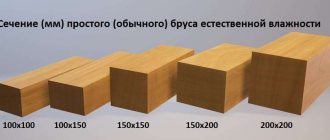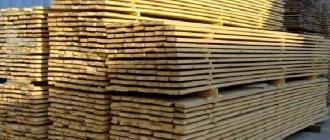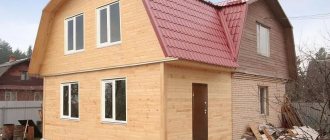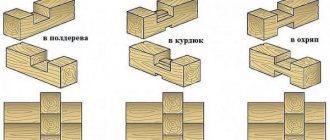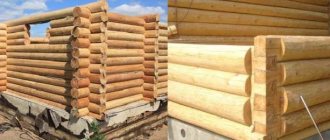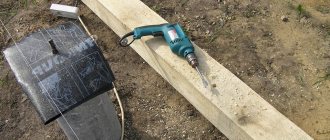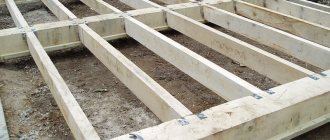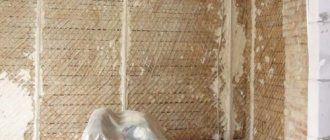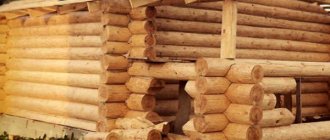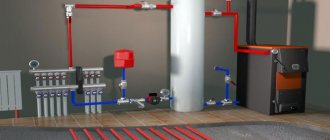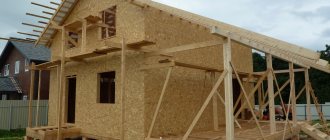timber is a type of large lumber with a thickness and edge width of more than 100 mm, made from logs by cutting off the side edges or from lamella boards by gluing. Currently, there are several main types of timber in production: edged, calibrated and planed. The first is a simple cut of wood without additional processing, the second has an ideally selected geometry, and the third, in addition, has been chamber dried and planed. Unlike boards, which in most cases are used for finishing work, beams, due to their high strength, are used as a material for creating enclosing and load-bearing structures.
In order to correctly select the amount of material during construction, we suggest using a timber cubic capacity calculator , which allows you to calculate the total volume of available material, the volume of one unit, find out the number of pieces in 1 m3, the total weight and cost of production. The service performs calculations only for four-edge assortments with rectangular and square sections. To start the calculation, fill out all the appropriate fields of the online calculator and click the “ Calculate ” button. If you want to use tables only, click here.
So, what formulas are needed when working with timber?
1. Area is calculated by multiplying two quantities: length and width
It is important here that both quantities are measured in the same units. The area of the timber is indicated in square meters;
2. To calculate the volume, you need to multiply the area by the height. Volume is measured in cubic meters.
When you need to find the volume of a beam whose dimensions are indicated in cm, you must first convert these values into meters, and only then perform the necessary calculations.
How to find out how many pieces are in 1 cubic meter of timber?
To find the required value, you need to divide 1 cube by the volume of 1 beam. For example, with timber dimensions of 150 x 150 x 6000, the volume of 1 piece of timber will be 0.135 cubic meters. To calculate how many pieces of timber there will be in 1 cube, you need 1 / 0.135 = 7.407 pieces. We round to whole units and get the required value - 7 pieces.
Table how many boards are in 1 cube (pieces/meters)
| Beam dimensions | Volume of 1st beam | Timber in one cube (pieces) |
| 100x100x6000 | 0.06 m3 | 16 pcs |
| 100x150x6000 | 0.09 m3 | 11 pcs |
| 150x150x6000 | 0.135 m3 | 7 pcs |
| 100x180x6000 | 0.108m3 | 9 pcs |
| 150x180x6000 | 0.162 m3 | 6 pcs |
| 180x180x6000 | 0.1944 m3 | 5 pieces |
| 100x200x6000 | 0.12 m3 | 8 pcs |
| 150x200x6000 | 0.18 m3 | 5 pieces |
| 180x200x6000 | 0.216 m3 | 4 things |
| 200x200x6000 | 0.24 m3 | 4 things |
| 250x200x6000 | 0.3 m3 | 3 pcs |
| 250x250x6000 | 0.375 m3 | 2 pcs |
| 250x300x6000 | 0.45 m3 | 2 pcs |
| 350x3200x6000 | 0.54 m3 | 1 PC |
For convenience in work, you can independently compile a table taking into account the different sizes of timber used in construction, and then use it to calculate the number
It is important to take into account some nuances:
when rounding numbers, it is important to assume everything is correct, otherwise minor deviations can lead to significant financial losses; if the timber has grooves or tenons, then only the dimensions of the working surface should be taken into account for the calculation; When choosing a product in a store, it is important to take with you an accurate table and calculate the required amount of timber, taking into account the exact dimensions.
When starting to build a house or other object, we first draw up an estimate of the necessary building materials. Correct calculation of materials used in construction allows you to avoid shortages or, more importantly, overconsumption.
This rule is relevant for any construction and wooden houses are no exception.
Calculation using an online timber calculator
Using special calculators that can be easily found on the Internet, the quantity or volume of wooden beams is calculated. It is important to note that such a program allows you to calculate both glued and profiled varieties of material.
The online calculator makes it possible to calculate the timber required not only for the construction of a residential building, but also for a bathhouse or gazebo. The main advantage of this method is the high computation speed. Using such an application, you can determine how much paint is needed to paint the surface of the timber, the number and cost of dowels, insulation, crowns, etc.
Thus, the online calculator automatically calculates most of the indicators necessary for construction. It is very important to choose the right type of lumber and indicate accurate data in the appropriate cells, labeled for convenience.
Profiled laminated veneer lumber is often used for the construction of houses and baths.
On a note! If an error is made, the calculator will produce incorrect total values, which can lead to a shortage or, conversely, overuse of wooden building materials. Therefore, you need to be careful when filling out the cells.
The exact data that determines the type of material can be found by reading the construction estimate. When using a timber calculator to build a house, you need to remember one more important rule: to determine the cube, you need to know the length of the wooden product. It must correspond to the standard value indicated in SNIP or tables (for example, 3 or 6 m). It is noticeable that these parameters are rounded and are the arithmetic mean of the length.
When choosing this indicator, experts recommend starting from the length of the walls of the future building. Let's consider what parameters are required in order to calculate how many pieces of 150x150x6000 timber are in a cube or its volume. First of all, you will need to measure the width of the product, as well as its height. Both of these indicators are calculated in millimeters. Next, you need to fill out the column that corresponds to the total length of the walls. Moreover, the figure must be indicated taking into account internal partitions, always in meters.
Then a cell is filled in, in which you need to enter the height of the walls (in meters), after which the area of window and door openings is indicated. This figure is calculated in square meters. All that remains is to fill out the column indicating the length of the beam in meters.
For the calculations to be correct, it is necessary to obtain accurate data on the width, length and height of the product.
Comparison of timber sizes 100x100 and 150x150
If you need to determine how much volume the selected natural material occupies, you need to multiply the volume of one product by the total number.
But when calculating the presented material, it is necessary to take into account the following recommendations:
As you have already understood, it is very simple to make the presented calculations, and you can do it yourself, without the involvement of specialists. If you know how many beams you need to build your house, wholesale prices, then you will be able to make the process of purchasing building materials accurately. After all, the construction process must take place with the calculation of the number of units of lumber for one or another wall, ceiling or stairs.
In order to correctly calculate the need for building materials, namely, construction timber, you need to know the formula for converting pieces into cubic meters. Often in regulatory documentation, in calculations and in prices, only one indicator is used - cubic meters, and for general information or for the convenience of calculations, an understanding of how many pieces of timber are contained in 1 cubic meter is required.
To ensure that the purchased quantity is sufficient for construction purposes, another 15% must be added to the volume. Then the material will certainly be enough for the stated purposes. But before this, it is necessary to determine the main indicators: length, area and volume of the required (or available) product.
External walls, gables and internal partitions
We calculate the planks for a house, taking into account the fact that the same approach is used to determine load-bearing partitions and external walls. Having imagined partitions, walls and pediments in the form of geometric figures, we find their area.
Next, we determine the area of the opening and subtract it from the figure obtained earlier. We multiply the thickness of the walls by the area and obtain the total volume of timber required for the construction of these structural elements. If you need to calculate the cubic capacity of the material, use the calculation algorithm given above.
Meter and its functions
The word “meter” is of Greek origin and translated from this language means “measure”. Even at school we are given knowledge about it. Firstly, this is the length of the path. Secondly, it corresponds to the distance that sunlight travels in a vacuum in 1/299792458 seconds. This unit of measurement appeared back in the 17th century, it was then that the decision was made to create a generally accepted and universally used measure of distance, which is based on natural phenomena that do not depend on the desires of people.
So, in France in 1791 it was correlated with the length of the Paris meridian. This was determined on the basis of geodetic and astronomical measurements made by scientists such as Delambre and Mechain. A standard for measuring it was also made according to these parameters. This sample was a ruler made of platinum, the distance between the ends of which was equal to the chosen length. But it turned out that this value is not accurate, so the meter was equated with other various quantities - in 1799, 1899, 1927, 1960. The last and final designation of the meter as a unit of measurement was established in 1983.
It turns out that the meter that is widely known and used in everyday life can be different:
- square;
- linear
And how these measures of measurement differ from each other, and how to transfer them from one to another, we will find out by considering the features of each of them separately.
Is it possible to convert square meters to linear meters with comments and examples
A situation often occurs when, when measuring a material, it is necessary to convert square meters into linear meters. But for this you need to know:
- The length that corresponds to the linear unit of measurement.
- The width, which is also represented by the same unit.
Let's look at a specific example: 12 square meters of linoleum need to be laid on the kitchen floor. On sale this material is measured only in linear units. Therefore, you need to know the width of the required linoleum, which corresponds to 2.5, 3 or 4 meters.
In this particular case, experts advise: purchase 4 m of linoleum with a width equal to 3 m or 3 m with a width of 4 m. This is explained by the following calculations:
- first calculation option: 4 (length) × 3 (roll width) = 12 square meters;
- second calculation option: 3 (length) × 4 (roll width) = 12 square meters.
In this particular case, 12 square meters corresponds to three or four ordinary meters. But these calculations are not scientific because they are made, as they say, by eye.
Another example that will help convert the usual meter length into area squares.
To do this, let's make calculations with kitchen furniture: the kitchen set has a length of 2.5 ordinary meters. We need to calculate the floor area that the kitchen set will occupy in the kitchen. To do this, we perform several mathematical operations:
- We multiply the length of 2.5 m by the width of the kitchen wall 0.6 m.
- We get the result - 1.5 square meters.
It is this digital indicator that will correspond to the area that the kitchen furniture will occupy in the kitchen.
The third example will concern calculations related to finishing materials. To finish the bath, you need to purchase 65 square meters of wooden boards. In a hardware store, this material is sold in 3-meter lengths with a cost per linear meter. That is, it is necessary to calculate how many ordinary meters of wooden boards are required for an area of 65 square meters. We perform mathematical operations:
- We specify the dimensions of the board: 300 cm × 10 cm × 0.5 cm (this corresponds to a size in meters of 3 × 0.1 × 0.005).
- We multiply the length by the width in the required unit of measurement (in our case, meters).
- We get the area of one board: 3 × 0.1 = 0.3 square meters.
- We calculate how many boards are needed for 65 square meters, that is, divide 65 by the area of 1 board: 65: 0.3 = 216.67, or 217 boards.
Ceiling and floor beams
If a house made of timber will be built on unstable soils, it is better to choose a monolithic foundation instead of a floor on beams. In all other cases, wood can be used.
Ceiling and floor beams most often have dimensions of 100 * 150 mm, with a pitch of 0.8-1 meter. Maximum structural rigidity is ensured if the beams cut vertically into the crowns. The total length and number of beams are calculated as follows:
divide the length of the house by the length of the step between the tanks and subtract one. For a house measuring 6-10 meters, provided that the step is 0.9 m, you will need 10 beams (1/0.9-1).
The standard length of beams is 6 meters; for 60 meters (6*10) you will need 60 linear meters. Considering the fact that lumber is sold in m3, let's consider how to calculate the cube of timber. In our case, knowing the cross-section and length of the beam, as well as the linear length, we obtain - 0.1*60*0.15=0.9 m3.
How many pieces of timber are contained in one cube?
How much timber is 150x150 cube 6 meters? This question is asked by almost every person who has decided to start construction. Simple arithmetic calculations will help us understand. Above, we calculated that the volume of such material will be equal to 0.135 m3. Thus, we need to divide one cubic meter by the resulting volume. So, one cubic meter of timber measuring 150x150 6 meters contains 7.4 pieces.
With a size of 4 meters and the same size, the number of pieces will be 11.11. And if you take a 100x100 beam, there are about 25 pieces.
There is also a table that can significantly save time on various calculations. It indicates the volume of 1 piece and the quantity in a cubic meter.
Calculation of cubic capacity of round timber
To calculate the volume of small batches of round timber, there are tables that take into account the average diameter of the trunk of each tree and the length of the log. Detailed tables can be easily found on the Internet.
Approximate table of cubic capacity of round timber m3
Trunk diameter, mmTrunk length1 m2 m3 m4 m5 m6 m8 m1400,0160,03490,0520,0730,0970,1230,1792000,0320,0690,0870,1470,1920,2290,3293000,0770,1650,2 50,330,4190,5190 ,563400,10,2090,3190,4290,5390,6590,924000,140,2780,4280,5770,740,91,254800,1890,4080,6180,841,061,291,78
It is convenient to use such a table when evaluating several logs. When calculating the volume of large quantities of forests, they take a different route. Round timber is stored in the most dense arrays.
Proceed as follows:
The timber is sorted by length. Two-meter scaffolding is folded into a separate edge.
Longer logs are grouped in another stack. The trunks are stacked, alternately orienting the bases and tops of the round timber in different directions. This allows you to get the most dense stack of logs. Individual logs are laid out in one line along the length of the stack. Solid wood must be stored in a shape as close as possible to a regular parallelepiped. The product of the width, length and height of the stack will determine the folding cubic capacity of the round timber. The result obtained is multiplied by a correction factor . So, for timber up to 2 meters k = 0.56, and for longer logs k = 0.5.
This method of determining the volume of round timber is closest to the actual volume of wood. Timber warehouse workers are fluent in all the subtleties of calculating this parameter. Without experience in this area, independent calculation may be far from being in favor of the buyer.
Calculation of lumber for construction
Currently, most suppliers and distributors measure lumber in cubes (cubic meters). An experienced buyer can easily determine how much and what he needs, but a person who is buying this product for the first time to build a house may encounter significant problems.
So, let's try to figure out how to determine the amount of material in a cube and protect ourselves from the dishonesty of a cunning seller.
Counting lumber is easy
Many years of experience in purchasing boards for construction shows that converting this raw material into cubes of pieces is not something particularly difficult. The only thing that is required is to calculate the volume of one beam or board, taking into account its width, thickness and length.
So, how many pieces of 100x150 timber are in a cube or how many of the most popular 50x150 boards are in a cube?
Let's start with the board. The most popular board today is 5 cm thick and 15 cm wide. The standard length is 6 meters. How to get the volume?
From the school mathematics course we remember that for this it is enough to multiply all the above dimensions. As a result, we will get the volume of the board in cubic meters. In this case, the calculations will look like this: 6.0 x 0.15 x 0.05 = 0.045
What does the result mean? The result of the calculations means that the volume of the board is 0.045 cubic meters. Therefore, there are 22 boards in the cube.
But what about the timber?
The wide range of applications of this type of profiled timber extends to:
- construction of walls of houses, warm verandas, baths, gazebos, and utility buildings;
- production of blanks used as load-bearing elements;
- use as a basis for arranging floor ceilings and interfloor ceilings;
- strengthening door and window openings of buildings;
- production of frames for interfloor passages, flights of stairs and landings.
The popularity and demand for this material is explained by:
- ease of installation (up to do-it-yourself construction);
- no need for adjustment operations (saving time);
- simplicity and convenience of storage and transportation;
- the ability to construct objects of various configurations with different standard sizes.
But let’s return to how many pieces there are in a cube of 100 by 150 timber. It is also not difficult to carry out such calculations.
The standard length of a profiled beam is 6 meters, while the thickness is 10 and the height is 15 cm. In the same way as in the example described above, we carry out the necessary calculations: 6 x 0.15 x 0.10 = 0.9.
Therefore, in one cube we get 11.1, that is, 11 bars.
It would seem that everything is really very simple. But due to such calculations, you can overpay when purchasing building materials.
What is the trick of calculations
Let's say you are interested in how to calculate the cube of a 150x150 timber. According to the above formula, we multiply the dimensions and get the volume of one beam 0.135 cubic meters.
How much timber is in a cube? That makes seven beams, doesn’t it? But the trick is that there is not a whole number of pieces in the cube. This is where unscrupulous traders can deceive us.
For example, you need a cube of a board - here are 22 pieces. Need a cube of timber - please - 7 beams. As a result, to build a small 6x6 house you will need 52 timber. By simple calculations (52/7 = 7.43 cubic meters) we can establish that we will not be given 3 timber.
Learning to count correctly
Let's return to the already tested example of 52 beams with a cross section of 150x150 and a length of 6 meters. We calculate the volume: 52 x 6 x 0.15 x 0.15 = 7.02 cubic meters. Actually, you have to pay for 7.02 cubic meters, and as a result you get 52 bars and no less.
What else to consider when choosing and counting lumber
There are some nuances that you should pay attention to before you start calculating building materials. For example, not many people know about such a parameter as the technological length of a product. This definition denotes the actual length of a beam or board, which most often exceeds the average length by 50-100 mm.
When selling this or that lumber, you need to focus on the standard length, which is 3, 4.5 or 6 m. There are other, less common sizes. Thus, the seller does not have the right to add additional centimeters to the traditional values. In general, it is not so difficult, knowing the necessary values, to determine how many pieces of 150x150x6000 timber are in a cube. The price of such products is calculated quite simply.
Glued laminated timber belongs to the category of the highest quality and most reliable lumber.
On a note! Before purchasing timber, experts recommend measuring its basic parameters. This is due to the fact that any real deviations that differ from the declared linear meters can lead to a serious error in the calculations. This rule is especially applicable in situations where the volume of material is quite large.
In addition to the basic geometric parameters, it is recommended to pay attention to the weight of the lumber. It is important to remember that this indicator depends not only on the dimensions, but also on factors such as the density of the wood and its moisture content.
In any case, you need to be careful when choosing material. During the calculation, it is advisable to check its accuracy several times. Moreover, it does not matter what method is used for these purposes. If necessary, you can always turn to specialists for help, who will carry out competent calculations not only of the bars, but also of all the materials needed to build a house or bathhouse.
Features of a linear meter
The very phrase “linear meter” is incorrect, because the most ordinary meter will be just that. This measure is established to determine the linear length of something. That is, it would be correct to say: the linear length of something is 1 meter. This means that one linear meter is a measure of the length of something, without the influence of other units of measurement, such as width, height, mass, etc.
The linear meter designation is most often used in the construction industry. So, in these measurement units you need to measure:
- materials that can be rolled (for example, fabrics or linoleum);
- hard materials (board, pipes or fittings);
- furniture sets (kitchen or bedroom sets).
In this case, the width of the material is included in its cost immediately before it is converted to length. Let's consider this feature using the example of rolled material. So, the fabric in a roll corresponds to 2.2 m (this is 220 cm), which means that a linear length of one unit will have a width in the digital value of 2.2, which corresponds to an area of 2.2 square meters.
Any length can be measured with such a generally accepted measure. This procedure is performed using a regular ruler, tape measure or some other measuring instrument designed for this purpose. Moreover, this unit of measurement corresponds to other measures that are also suitable for measuring the length of something:
- 1000 millimeters.
- 100 centimeters.
- 10 decimeters.
Most often in everyday work it is customary to use the meter, and not the units of measurement that are included in it.
Rafter system
Consider the option with a gable straight roof. The pitch of the rafters is 60 cm, the roof angle is 45°, the cross-section of the material is 100-150 mm. Remember that the greater the angle of inclination, the lower the maximum mass of snow that can accumulate on the roof, but at the same time the windage of the roof increases.
In windy regions it is better to create a rafter system with a smaller slope, in snowy regions - with a greater one. The smaller the pitch of the rafters, the smaller their cross-section can be chosen. This is explained by the uniform distribution of the load.
The design of the rafter system is extremely simple - there are 2 rafter legs above the middle of the house. They are fixed with a longitudinal girder using a beam of the same section. It is used to connect the vertices of triangles.
Approximate price for timber
A solid beam is a regular log, processed along four edges to give the correct geometric shape. Even despite the far from the most advanced technology for its production, it is quite possible to build from such material not only a budget bathhouse, but also a decent country house for permanent residence. In any case, it will be several times cheaper than a house made of laminated veneer lumber.
We analyzed the current state of affairs on the Russian building materials market and compiled a small table that reflected the average price range per cubic meter and linear meter of solid timber.
Below are the most popular sizes of non-profiled material, both natural moisture and dried to optimal humidity. Indicative data on prices for non-profiled solid timber (2013)
| Section dimensions, mm | Price per cube | Price per linear meter | ||
| natural humidity | dry (humidity 18-20%) | natural humidity | dry (humidity 18-20%) | |
| 100×100 | 5000÷5500 rub. | 9300÷10500 rub. | 50÷55 rub. | 93÷105 rub. |
| 100×150 | 5000÷5700 rub. | 9300÷10500 rub. | 75÷85 rub. | 140÷160 rub. |
| 100×200 | 5000÷5700 rub. | 9500÷10500 rub. | 100÷120 rub. | 190÷210 rub. |
| 100×250 | 5000÷6500 rub. | 9600÷10500 rub. | 125÷165 rub. | 240÷265 rub. |
| 150×150 | 5000÷5700 rub. | 9500÷11000 rub. | 115÷130 rub. | 215÷250 rub. |
| 150×200 | 5000÷6000 rub. | 9500÷11000 rub. | 150÷180 rub. | 290÷340 rub. |
| 150×250 | 5000÷6500 rub. | 10000÷11000 rub. | 190÷250 rub. | 380÷420 rub. |
| 200×200 | 5500÷6500 rub. | 10000÷12000 rub. | 230÷270 rub. | 420÷500 rub. |
Prices may vary from company to company. Much depends on the quality of the lumber, compliance with the declared dimensions, and production technology.
What is the weight of the beam?
This parameter depends on the type and moisture content of the wood. Humidity is the percentage of the weight of water to the weight of dry wood. The moisture content depends on the duration of drying, as well as the conditions for further storage of lumber.
Dry wood is wood that has undergone technological drying or has been in a warm, dry room for a long time.
Raw wood is a material at the drying stage from the freshly cut state to the equilibrium state.
Air-dry wood is lumber with equilibrium moisture content. When stored in natural conditions, the timber acquires humidity balanced with the level of air humidity.
Wet and freshly cut wood is material that has been in water for a long time or has been recently cut down.
The question of how to calculate the cubic capacity of wood building materials worries many developers. In order not to overpay for excess production or to avoid getting into a difficult situation when you have to stop construction due to a lack of lumber, the correct methodology for counting timber is required.
Answers from experts
zv:
For what exactly? For laying the floor?
Evgeny Melnikov:
6x6 mm? Not enough for a garage
Andrey Sharikov:
50*150*60006000/150=40 boards in a cube 50*150 22 boards. This is half. You can see what you can make of the logs yourself.
Corporal:
A strange question for an adult. Volume = length times width times height (or thickness). Then cover the entire garage with boards around the perimeter, throughout the entire volume, or just the floor, or the floor and ceiling...?
Rudy:
maximum 1.5 cubes if for the floor. forty.
Waldemar Henzel:
2 cubic meters is enough!! - depending on what you want and how - if you’re not a fool!!!
Dear John:
multiply the height by the width and length, you get the volume, that’s how many boards will fit into your garage
realist:
6 cubes...
port port:
What kind of floor design is that?! Wooden flooring on concrete slabs or on the ground?! If on concrete, then everything is quite simple.
6*6*0.05=1.8 cubes Take 2 cubes, taking into account trimming for flooring.
Plus, there are lags - but who knows what kind of car you have and at what step you will install these lags. If after 30 centimeters, then take another 0.5 cubic meters of 50x50 timber so that the floor does not sag.
But if it’s on the ground, it’s a whole story with brick columns and the logs need to be much thicker.
Why are you buying computers in Russia?! How are you going to defeat America?
Oleg:
A lot of species can be called mahogany, red species include padauk and kempas. kumaru, doxia, amaranth, common and predictable is merbau. It combines very good hardness properties. and hygroscopicity, can be used both indoors and outdoors. The merbau cube depends on what you want to use it for. In wood, the price depends on the size of the planks (boards). the larger the size. the more expensive) Size matters)) Like Godzilla: -))) The average price will be per cubic meter. m. about $2667 if in dollars and of a good grade) More precisely, if you tell me the size and what to use it for, if in sq. m. m then from about $40 1 sq. m
Vitalban1:
mahogany?? ? 1 cubic meter = 1 cubic meter 100 dollar bills
Sergey Zainyshev:
The question is asked incorrectly, a cube of wood and a cube of sawn wood, and a cube of processed wood, these are different prices. but if in Africa, then a cube of mahogany wood = about 1 dollar. but mahogany =it's color= different. like we have aspen and poplar in Russia
In St. Petersburg, a mahogany board costs $2,000 per cube; in private advertisements you can find it cheaper
Vladimir Skap:
What are you saying? I asked how much is 1 cube of mahogany?
Self-calculation
You can independently determine the number of pieces of boards.
To do this, you need to measure the stack and calculate the volume of the packaging. Knowing the dimensions of the lumber, the volume of a unit of production is determined. The quotient of dividing these two parameters will give the real number of pieces of boards.
For example, a board has dimensions of 200 x 30 x 6000 mm. Therefore, the volume of lumber will be equal to 0.036 m3. 1 m3 will fit – 1 / 0.036 = 28 pcs.
In order not to bother with measurements and calculations, you can use tables. For edged material 6 meters long, the table will look something like this:
Section, cmVolume 1 piece, m3 Quantity in 1 m3, piece2.5 x 100.01566.52.5 x 150.02644.34 x 100.023941.74 x 150.035627.84 x 200.047820.95 x 100.03233 .25 x 150.04622.15 x 200.0616.65 x 250.074813.2
For unedged boards, indicative tables are used, taking into account the variable width along the entire length of the product unit. The volume of wood is calculated using the same method as the volume of trimmed material, with the introduction of a correction factor k ranging from 0.6 to 0.8. The magnitude of the coefficient depends on the degree of curvature and thickness of the cortex.
A table of volumes of unedged wood 6 m long with conditional k = 0.7 will be as follows:
Section, cmVolume of 1 piece, m3 Quantity in 1 m3, piece2.5 x 100.01546.62.5 x 150.025531.24 x 100.02429.24 x 150.03619.34 x 200.04814.55 x 100.0323 .25 x 150.04515.55 x 200.0611.75 x 250.0759.2
NOT included in the calculation
- wall panel
- household appliances, sink and mixer
- drawers, beveled, bent and radius elements, decorative canopy, lighting, internal filling of cabinets, closers and gas lifts.
Keep in mind: each manufacturer has its own set of modules, materials and components for calculating a linear meter. Some people don’t take the countertop into account. Others don't take into account the base or baseboard. Still others make room for a free-standing stove instead of a built-in oven. Still others “forget” about hinges and handles...
The purchase price of materials and accessories from manufacturers also varies. Therefore, it is wrong to consider a manufacturer cheap only in terms of the cost of a conventional meter of a set of kitchen furniture.
Ask the seller what exactly he includes in a standard linear meter. What height and depth do the modules have? If you come to the salon, ask to see a sketch of the kitchen design project on the basis of which the calculation was made.
If a kitchen furniture manufacturer has described this in detail on its website, this is a good sign. There is a greater chance that the price will be adequate, and the calculation method will be transparent and without hidden extra charges.
What is the main difficulty in calculating the linear meter of lumber?
The main difficulty is how to calculate the linear meter of timber required, for example, for building a house. The fact is that most lumber manufacturers quote the price for their products in linear meters, not in cubic meters, and when ordering a large amount of material you will have to pay not per linear meter, but per volume.
It is easy to understand that this means the number of boards of a certain molding that fit into one cubic meter. And in order to order the required number of boards or lining for covering the area, you need to convert one linear meter of material into a cubic meter. Theoretically, this is quite simple to do; for this you need to know the width and height of the products from the manufacturer, and make simple arithmetic calculations.
Why is it important to use standards?
When calculating the amount of materials needed for construction or cladding, difficulties often arise when converting from one unit of measurement to another. Often, private developers who are going to build a house from lumber, or clad a finished building using timber, lining or a block house, make incorrect calculations due to errors in determining the required amount of material. In the field of construction and installation work, several units of measurement of materials are used in accordance with the area of their use. The basic unit is the linear meter.
We practice calculating cubic and linear meters of lumber
For example, if we are given a linear meter of 150x150 timber with a length of 6 meters, then knowing the design data for the future house, we must calculate how many cubic meters of material we will need. First, let’s find out how many cubic meters there will be in one product 150x150.
To do this, we simply multiply all the values in meters, i.e. 0.15x0.15x6=0.135 m3 is available in one board. Now we calculate the number of products in one cubic meter, to do this we divide one meter by the resulting volume: 1/0.135 and we get 7.4 pieces. That is, in one cubic meter of lumber 150x150 mm and a length of 6, almost seven and a half pieces fit.
Knowing the design area of walls for cladding or other types of work using timber, it is easy to calculate the number of cubic meters of lumber for the project. The same calculation methods can be used for products of other sizes. For example, we need to count. how many pieces of 100x100 mm boards will be in one cubic meter of lumber when ordering. To do this, knowing the linear meter of the product, we perform simple calculations. Let's say the beam is 5 meters long. We count in meters: 0.1x0.1x5=0.05 m3. And in one cubic meter 100x100 you get exactly 20 pieces.
For the convenience of customers, many manufacturers offer convenient calculators on their websites for calculating linear and cubic meters of lumber. You just need to enter the cross-sectional dimensions of the product, as well as the length, and the calculator will immediately display the volume of 1 m3 of timber, as well as the number of pieces in one cubic meter. Many calculators also immediately show the cost of products in linear and cubic meters, which greatly simplifies the buyer’s task when ordering the required amount of material.
Calculations of the amount of timber in accordance with your project
If you have independently developed a house construction project and want to know how much material you will need per linear and cubic meter, you need to take into account the size and area of all elements of the future structure of the house. Most projects of wooden houses made of timber today have a wooden frame and walls, as well as a roof truss system based on lumber.
To calculate the required amount of lumber for your project, first decide what kind of lumber you will need. Typically, several types of this material are used within one project. For example, a strong 150x150 beam is used for the frame, a thinner 100x100 can be used for the walls, and a 50x50 mm product is used for finishing. Find out the linear meter of timber used in the construction of your house and make calculations based on the required number of structural elements.
For those who are interested in the question of how to convert square meters into linear meters, our specialists will give a definite answer. No way. Why? To understand this, you need to know the features of each of these units of measurement. And what should you do if you need to translate them? This will be discussed in this article.
General information on the calculation results
1. Total timber volume
— Estimated amount of lumber in cubic meters.
2. Total wall area
— The area of the outer side of the walls. Corresponds to the area of the required insulation, if provided for by the project.
3. Total weight
— Weight of timber excluding insulation.
4. Number of crowns
— Number of rows of timber in one wall. Depends on the height of the walls and the size of the material used. Excluding gables.
5. Amount of roll insulation for all crowns
— Equal to the total length of all beams.
6. Diameter and number of dowels in 1.5 meter increments
— This calculation is suitable only for lightly loaded timber buildings. For critical buildings, the calculation of dowels must be carried out by specialists in your region.
7. Amount of impregnation on both sides
— The calculated amount of protective impregnation of medium grades, covering the external and internal surfaces of all walls.
8. Approximate shrinkage (4%) of profiled timber
— Approximate shrinkage of walls made of profiled timber after 1 year, with an initial humidity of 20%.
9. Load on the foundation from the walls
— Load without taking into account the weight of the roof and ceilings, with support on the entire surface of the lower crown. This parameter is necessary to select the strength characteristics of the foundation.
What determines the price of timber?
To begin with, we list the main factors that determine the cost of timber:
- wood type;
- type of timber;
- its dimensions;
- lumber processing;
- their humidity;
- volume of the purchased batch;
- seasonality
Now let's take a closer look at each of them.
Wood type
Its quality largely depends on the type of wood, which determines the final cost of the timber. Each species is characterized by its strength, moisture resistance, the presence of knots and other defects
The prevalence of a particular type of wood is also important. Obviously, the easier it is to obtain raw materials, the cheaper it will cost
Most often they prefer coniferous species:
- spruce. The cheapest timber is produced from it, and accordingly, prices for houses built from timber will be relatively low. But it is worth considering that the lumber obtained from it is replete with knots, and if additional treatment with antiseptics and fire retardants is necessary, this will not be so easy. Ripe wood has a yellowish-white color; in the cross-section, growth rings and resin ducts are clearly visible. It paints well, but due to its dense structure it is difficult to impregnate. Spruce timber outdoors is exposed to atmospheric influences and quickly loses its original appearance;
- pine. It costs a little more than spruce, but does not have many of its disadvantages - it is most often used in the production of timber. The wood has wide growth rings, is resinous, and evenly darkens after sawing. Pine timber is more resistant to atmospheric influences than spruce timber, but it is also necessary to impregnate it with protective compounds;
- fir. The wood is lighter than that of spruce, not resinous, but their structures are very similar;
- larch. It has a dark brown core and narrow light sapwood. It pricks easily, so you need to be careful when carrying out finishing work, in particular, when driving nails into a wall made of timber, you must first drill holes
Hardwood is also used to produce timber, but we will not dwell on them in this article.
Grade
There are grades of timber from 0 to 3. The lower the value, the better the quality. Grade 0 is the most expensive and involves the use of selected wood. But most often on sale you can find timber of grades 1 and 2, which have some defects, but are quite suitable for building a house or bathhouse.
Beam size
If we consider solid material, then it is natural that the price for it will be higher, the greater the width and thickness. The length is usually set to 6000 mm. You can find on sale timber with sections 100×100, 100×150, 150×150, 200×200, etc. This parameter determines the thickness of future walls, their heat and sound insulation characteristics. Carefully check the compliance of the sizes declared by the seller, because... Today, cases of selling 90×140 timber instead of 100×150, etc. have become more frequent. - such a “small error” will negatively affect your wallet and the quality of construction.
Moisture content of lumber
The higher the costs in the production of timber, the higher the cost of the final product. Therefore, it is not surprising that dry timber costs 2 or even 3 times more than material with natural moisture. It should be taken into account that the initial costs of dried material pay off during the operation of the house. Wet timber shrinks greatly, cracks, and changes its geometric dimensions, which forces full-scale finishing work.
Additional processing
Sawn material without any drying is the cheapest. The so-called solid timber of natural moisture is usually used for the construction of country houses or baths. The price for processed lumber: dried, planed, profiled is always higher than for solid lumber. Separately, we should consider laminated veneer lumber, which is produced using more advanced technology, hence the cost of truly high-quality material reaches unimaginable heights.
Scope of delivery
Of course, the price of timber will be different for wholesale and retail buyers. If you are planning to build a large house, you can benefit from its cost by ordering all the required materials from one company. Don’t forget to immediately calculate exactly how much timber you need for your house - this will save your money and time in the future.
Information on the purpose of the calculator
The online calculator for profiled and laminated timber is designed to calculate the quantity and volume of lumber for the construction of houses, bathhouses and other buildings. The amount of inter-crown insulation, dowels, crowns, cost and anti-corrosion impregnation is automatically calculated based on the average value. For more accurate calculations, be sure to contact specialists in your region.
When filling out the data, pay attention to the additional information with the sign ❗
To understand the advantages and disadvantages of profiled timber compared to laminated veneer lumber, you should start with the basic concepts about the production of both.
Profiled timber is made from coniferous trees. In most cases, it has standard section dimensions:
- 100x100 mm - best suited for building a bathhouse or summer country house
- 150x150 mm - suitable for a good home
- 200x200 mm - for the construction of large wooden houses or cottages
If desired, you can individually order timber of a different section. The appearance of the timber can be either with a straight front side or with a D-shaped one. A log of the required thickness is processed on planing and milling machines, after which it is ground on the required sides. The side of the beam that will be located inside the future house and may not require further finishing is usually subjected to high-quality sanding. For convenience and reliability of installation of a log house and for protection from cold and moisture, the profile most often comes with 1 or 2 tenons for a lightweight structure or a “comb” for a residential building. The finished log house must shrink for further completion of construction, usually this period is about 1 year. To reduce this period to several months, you can dry the timber in advance in special chambers.
To produce laminated veneer lumber, logs are sawn into boards, which are also called “lamellas”. The boards are cut and placed in a drying chamber, where the soft drying process produces material with a moisture content of about 10%. The boards are then planed again to the required dimensions, sorted, and then glued into timber using a hydraulic press. For gluing, special waterproof adhesive compositions are used. To make laminated timber resistant to rotting and significantly increase its strength, the boards are laid in a special way - each is laid opposite to the cross-section of the fibers of the neighboring one.
When assessing the strength of materials, it is necessary to recognize the best performance of laminated veneer lumber.
In profiled wood, during the production process, the outer, stronger part of the wood is cut off to give the desired shape. Glued laminated timber, due to the previously described method of laying boards and gluing them on a hydraulic press, is more durable. As many people know, larch is the most durable and rot-resistant, but also the most expensive among conifers. Making profiled timber from it significantly increases the cost of construction. When producing laminated veneer lumber, it is possible to lay an external larch lamella before gluing, which has a slight effect on the increase in price.
When comparing the moisture content of the material and the shrinkage time, it has already been noted that laminated veneer lumber has a moisture content of about 10% and, accordingly, a short shrinkage time, which makes it possible to reduce the construction period of a house. Profiled timber has the natural moisture content of wood, and even drying it can reduce the moisture content only to 20%, so shrinkage cannot be avoided. When comparing shrinkage periods, we must not forget the fact that solid material, due to its greater massiveness, is practically not susceptible to cracking, but on laminated veneer lumber there is a possibility of small cracks occurring.
Due to technological manufacturing features, each type of timber may have different overall dimensions. The profile usually has a length of up to 6 meters, and a cross-section of 100x100, 150x150 and 200x200 mm. Manufacturing timber of a different section size (for example, with a step every 10 mm) can increase the amount of waste, which cannot but affect the price. The length of laminated veneer lumber can reach 12 meters, and the cross-section is usually made from 80 to 280 mm.
In terms of cost, solid timber is almost 2 times cheaper due to the less complex manufacturing process.
But taking into account only the cost of the finished log house, do not forget that finishing for facades when using laminated veneer lumber may not be required, and comparing them in price is a stretch. Everything will depend on the material chosen for finishing the house, its quantity and cost.
In terms of environmental friendliness, profiled timber is not just a favorite, but rather a champion, preserving all the beneficial properties of such an excellent material as natural wood. For processing, you may only need special mixtures to protect against fire and rot, which the owner of the house can choose. In the production of laminated veneer lumber, adhesive compositions can be used, which are divided into several groups according to the degree of danger, and it is not a fact that the manufacturer did not decide to save on the cost of the glue.
In conclusion, we can say that each of the 2 types of timber considered has its undoubted advantages with a small number of disadvantages. And only the owner can decide what material to build the house from in order to continue living in it.
The following is a complete list of calculations performed with a brief description of each item. If you haven't found the answer to your question, you can ask it in the comments.
